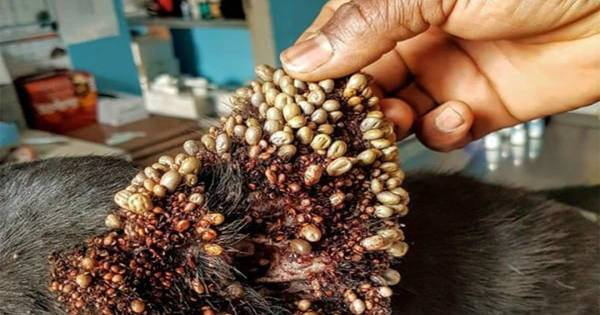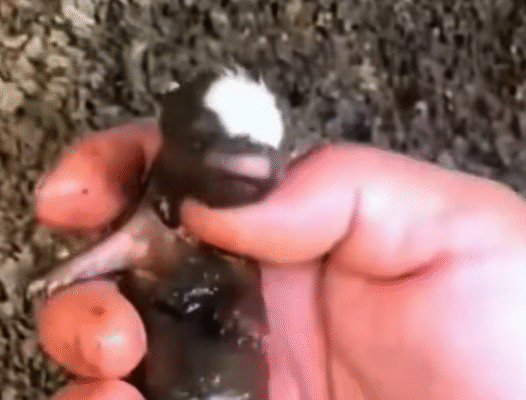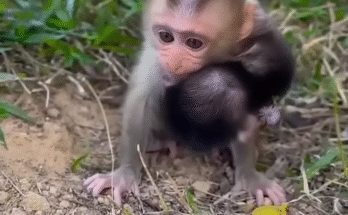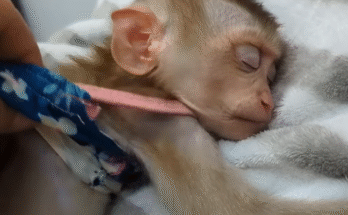It was a crisp spring morning when twelve-year-old Lily wandered through the tall grass at the edge of her family’s property in the countryside. The sun was just beginning to rise, casting golden light over the dew-soaked meadow. She had always loved being outdoors, especially early in the day when the world felt peaceful and quiet. That morning, she had no idea her life was about to change in the most unexpected way.
As she wandered along the hedgerow, she heard a faint, high-pitched squeaking sound. At first, she thought it might be a bird. But then she noticed a small rustling in the grass near her boots. Curious, Lily knelt down and carefully pushed aside the blades of grass. Her heart skipped a beat when she saw a tiny creature curled into a trembling ball — no larger than a hamster, with soft brown fur, a cream-colored belly, and bright, terrified eyes. It was a baby stoat.

Lily had seen stoats in books before — long, slender creatures with sharp minds and swift movements. But she’d never seen one in real life, especially not a baby. This one looked far too young to be alone. It was shivering from the morning cold and let out another pitiful squeak.
Lily glanced around, hoping to spot its mother nearby, but the fields were silent. She waited and watched for over an hour, hoping an adult stoat would return. But none did. Her instincts told her that the baby wouldn’t survive much longer on its own.
“I can’t leave you here,” she whispered softly.
Using her scarf, she carefully wrapped the tiny animal and held it close to her chest for warmth. It relaxed slightly, nestling into her hand. Lily knew what she was doing was risky — wild animals usually needed professional help — but something deep inside told her she was meant to help this little one.
Back at home, she tiptoed through the back door, hoping not to wake her parents yet. She went straight to the old rabbit hutch in the shed and filled it with hay, soft cloth, and a warm hot water bottle. Then she placed the baby stoat gently inside.
She named him “Whiskers,” because of the tiny, twitching whiskers on his face that never seemed to stop moving. She spent the rest of the day researching how to care for a wild stoat. She learned that they were carnivores and needed protein-rich meals. For the first few days, she fed him kitten formula from a tiny syringe, holding him carefully as he drank. His eyes stayed fixed on hers, wide and trusting.
As the days turned into weeks, Whiskers grew stronger. He began to explore the inside of the hutch, hopping over Lily’s fingers and tugging playfully at her sleeves. His fur became sleeker, and his tiny teeth began to come in. Lily built him a safe playpen in the backyard with branches, tunnels, and toys. Each day after school, she would sit with him, letting him climb all over her shoulders and curl up in her hoodie pocket.
At first, her parents were cautious. “He’s a wild animal,” her mother reminded her. “He’s not like a dog or a cat.”
“I know,” Lily said. “But he needed me. And I think… maybe I needed him too.”
And it was true. Lily had always been a quiet, shy girl. She didn’t have many friends at school and often felt like she didn’t quite fit in. But with Whiskers, she felt different — like she had a purpose. He made her laugh. He gave her confidence. And most of all, he trusted her.
Soon, Whiskers began to show off his natural stoat talents. He could dart from one end of the garden to the other in seconds. He learned to leap, climb, and even hide in the most surprising places — inside boots, under flowerpots, or wrapped in the folds of a towel. Lily made videos of his antics and started sharing them online. To her surprise, people from all over the world fell in love with the little stoat and the gentle girl who rescued him. She gained thousands of followers who cheered on their journey.
By summer, Whiskers was nearly full-grown. He was sleek, fast, and alert — a beautiful animal that was clearly healthy and thriving. But Lily started to worry. She knew wild animals didn’t always do well in captivity. She had raised him with love, but now she faced a difficult question: Should she let him go?
She spoke with a local wildlife expert who was amazed at how well Whiskers had grown. “He’s healthy enough to return to the wild,” the expert said. “But he’s bonded to you. It’s not an easy decision.”
Lily spent several days thinking it over. Every time she looked at Whiskers curled up beside her or darting through the garden, her heart ached. But she also saw the wild glint in his eyes — the yearning to run through forests, to hunt, to be free.
So one quiet morning, just like the one when she first found him, Lily took Whiskers to the nearby woodland. She opened the carrier and knelt beside him. Whiskers sniffed the air, his nose twitching with excitement.
“It’s okay,” she whispered, her eyes filled with tears. “You’re ready now.”
He looked at her one last time, then bounded out into the underbrush, disappearing into the wild like a flicker of sunlight through leaves.
Lily sat there for a while, the empty carrier beside her, feeling both heartbroken and proud. She had saved a life. She had raised him with care and courage. And even though he was gone, he had given her something she would carry forever — the knowledge that she could make a difference.
Weeks passed. Every time she walked near the woods, she wondered if he was out there, thriving. Then one evening, as she sat quietly reading on the porch, she heard a rustle near the fence. She looked up — and there, just for a moment, was Whiskers. He stood still, watching her with those same bright eyes. Then, just as quickly, he disappeared into the night.
Lily smiled.
She knew it wasn’t goodbye. Not really. Some bonds — no matter how wild — never truly break.



